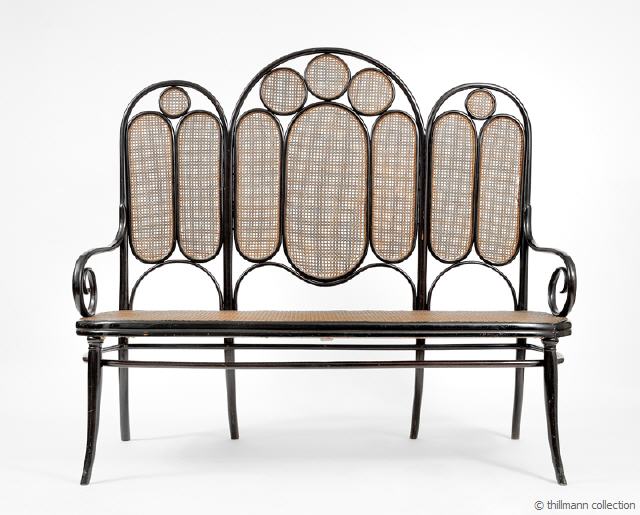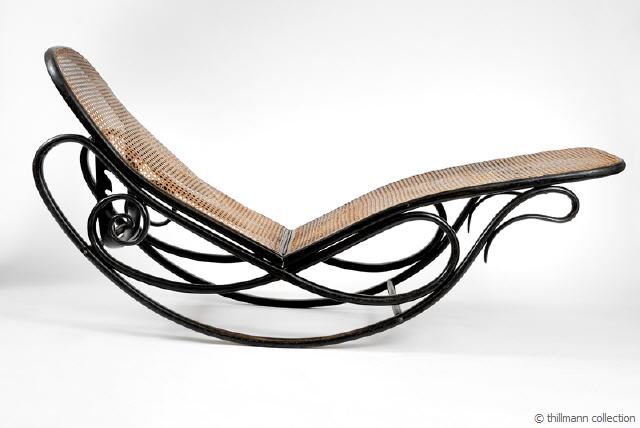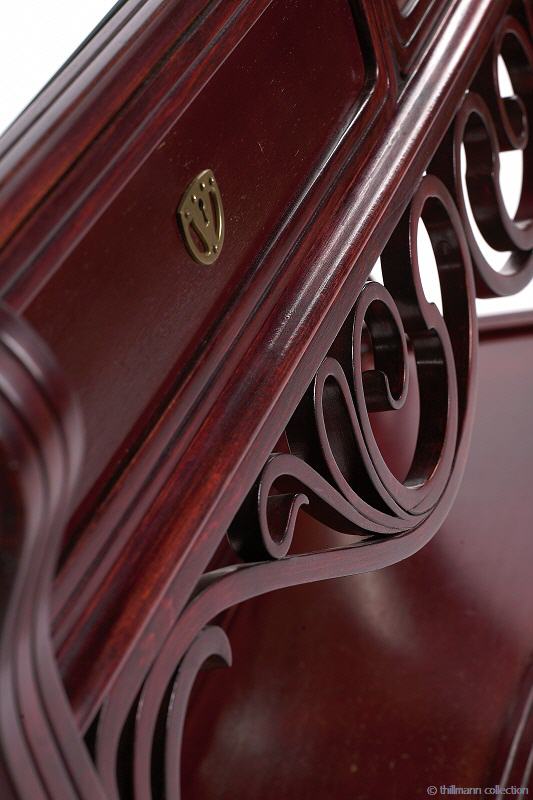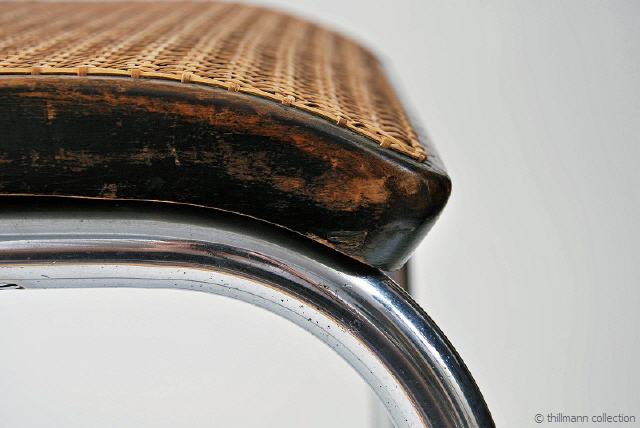Collection
The collection has been built up since 1990 and holds, beside a lot of different types of furniture, original documents like catalogues, broadsheets and a comprehensive archive of all aspects of bentwood history. The collection represents the period up to 1950.
Highlights of the collection are two examples of parquet floor made from the “Brothers Thonet” in the 1850s and a reading table with a laminated spiral base. The top of this table shows pattern of parquet floor No.XIII “en miniature”.
The early pieces of both the Thonet Company and their competitors are the main part of the collection. Beside laminated pieces you can see the earliest massive bent models which impress by their elegance and fineness. Just the change from completely laminated via the partly massive and then glued ones to the completely massive produced pieces makes visible the technical as well as the creative performance of Michael Thonet. Bentwood history becomes vivid.
Early pieces
The Viennese competitors
The furniture of the Viennese competitors consists of both solid wood and laminated wood. The „Gebrüder Thonet’s“ patent for bending solid wood was granted in 1856 and ran out in 1869. So the competitors were forced to produce furniture in the traditional way or in the technology of laminating. Most of these Viennese workshops had to close down the production in 1870 - 80 because the manufacturing process was no longer economical at that time.
The 1867 broadsheet

The 1867 sales poster contained all of the essential information that can be found in the later sales catalogues. As in the later sales posters and catalogues, special attention is given to the most recent award received, in this case the gold medal awarded during the 1867 World Exhibition in Paris. Next to it, the factories in Corycany and Bistritz are depicted. The branch-stores in Vienna as well as those in London, Paris, Linz, Rotterdam, Pest, Brünn, Berlin and Hamburg are mentioned with their respective addresses.
The furniture pieces were now marked unambiguously: chairs, armchairs, sofas and tables are each indicated by a number, other items of furniture have unique names such as „Damenfauteuil“ [lady’s armchair], „Drehstockerl“ [revolving-stool], so that no misunderstanding could arise during orders.
The sitting furniture with the numbers 1 to 6 and 13, 16 and 17 is depicted as a group, consisting of chairs, armchairs and sofas. Item number 9 could also be purchased as a group, but the sofa was only listed in the price list. Except for the items nos. 16 and 17, all sitting furniture was available either caned or upholstered.
In total, six different models of tables were offered. The dimensions of the tabletops were indicated both in inches and centimetres. Table no. 6 could be bought separately, either as a console-table or as a extendable dining-table, but is depicted only in the version with fixed tabletop. Stands were also available separately for all six models, so that they could be combined with a specific tabletop as desired.
For table models nos. 7, 8 and 9, only the stand and frame were available. These models were specially designed for marble tops in various dimensions.
The price was printed for the first time, in a section called „Preis-Courant“ [price news] at the bottom of the sales poster. The delivery costs were also displayed in a separate column.
The margins contained information in German, English and French on the specific production method of each piece of furniture, indicating the resulting advantages, the saving of space during delivery and the various stain colours in which all furniture items were available.
The published sales posters displayed an ever growing number of models. They were not intended to give a complete overview of all Thonet Brothers` products, but rather to present a selection of these in a graphically appealing and balanced way. In 1883, the first known „sample album“ was published. The sales poster with its limited size could no longer contain information about all of the many and various types of furniture. The firm decided to print a catalogue so that the customers could be offered a truly complete product overview. By this stage, the number of models of items of furniture had risen to 210.
The catalogues continued to grow, were sometimes multilingual, and allowed the customer to choose his furniture with its matching colour and form variety. Special catalogues were published for theatres, cafes and hospitals. One catalogue was called „Lawn-Tennis“ and offered all furniture which was required for enjoying this game. The complete catalogue of 1911 with the supplement of 1915 together contained 2000 different furniture models, respectively varieties of basic models.
Thonet in Historicism

The collection shows interesting individual pieces of the period 1870 - 1900, the epoch of the world-wide expansion of the bentwood market. Many objects of that period - Thonet's as well - echoed the taste for historism furnishings, offering Gothic- and Renaissance- revival furniture in bent wood with carved crest rails, turned or carved legs, and tufted and fringed upholstery to appeal to the shifting fashions and interiors and the consumer's wish for stylish display. Those designs haven't got anything to do with Thonet's idea to create furniture in superior quality and demanding natural elegance and grace.
The furniture you can see in the Historicism Gallery was shown in the exhibition "Möbeldesign- Roentgen Thonet und die Moderne". They cover an advertise from 1865
and show a cross section of the production at that time. The mass market furniture for the public sector provided undoubtedly the main source of the company’s income, but they wanted to equip the domestic sector of the middle class with bentwood furniture, too.
Already in 1860 the first rocking chair made from bentwood was produced in Koritschan factory. The examples for this come from England and could be manufactured - for structural reasons - previously only in metal. Beside very light and elegant furniture designs such as the Ladies armchair or a Folding armchair also heavy and representative seating furniture was made: No. 16 armchair and a matching settee with the same model number. Both back shape is reminiscent of Gothic church windows, which is why they received in the internal communication of the company, the term "Gothic" chair or armchair.
The stool is a practical furniture and the first of its kind was made in the early 1860s as well as the footstool under the settee.
However, not only chairs were offered. Tables were produced already in the second half of the 1850s. Table No. 5 with its numerous ornamental motifs is one of the most impressive ones. Later we can see other fine furniture that demonstrates on the one hand, the preference of historicism for ornamental, ornate shapes, demonstrating impressively on the other side but also the possibilities of wood bending such as standing mirror "Psyche".
Historicism-Gallery
August Thonet

The period which produced the models incorporating historicist references of such dubious aesthetics was contrasted at this time by work which is attributed to August Thonet, the third oldest son of Michael Thonet. August, who was in charge of the Bistritz factory from 1869, gave decisive leadership to these developments. His technical and constructive expertise led to a series of „experimental chairs“. Contrary to the ruling trend imposed by the prosperous middle class he developed complex and innovative experimental prototypes, which were too far ahead of their time to become a commercial success.
For the 1867 World Exhibition in Paris, he developed the model that is known today as the „demonstration chair“, which very effectively demonstrates the possibilities of bent-wood . He designed a chair made of two single wooden bars, each several metres long. This chair was shown at every exhibition where Thonet furniture was at display.
August Thonet also invented new machinery. He developed a machine to make circular seat frames. It is very likely that he led the creation of models nos. 51 and 91, as well rocking chaiselongue no. 7500, which is considered by many to be the most elegant bent-wood design ever.
The structural angularity of the design of model no. 51, which was available as a chair, armchair, stool and a flower-table stand, represents a fresh approach which produced an innovative variant to the bentwood aesthetic. Like chair no. 14, which is indicative of what we currently call „design“, this model is composed of only six parts. The double backrest loops and especially the brilliant, interwoven chair leg construction give this model a great strength and stability. The engineering mind of August Thonet is clearly present. Similarly, new solutions were also being created elsewhere by other manufacturing processes. The development of iron and steel technology was playing a primary role in generating a new dynamic in the aesthetic simplicity of the new skeletal space-frame buildings of the 19th century. Unfortunately bent-wood furniture was not considered by some with influence to have much aesthetic merit or artistic value: The significance of a cultural influence in the longer term was similarly not obvious. Jakob von Falke, the later director of the Austrian Museum for Art and Industry complained about the „slight, thin rods, whereas the eye desires a significant object, which expresses itself through its shape and colour.“ The importance of August Thonet‘s designs were not recognized in his time.
The collection holds the rocking chaiselongue in both versions: with and without armrests.
Viennese Seccession

After a period in which the furniture design of the leading bent-wood producers was dominated by stylistic imitation, a new movement arose around 1900. It became famous under the name „Jugendstil“ or „Reform Movement 1900“. Inspired by the social reformer William Morris, architects in Belgium, France, Germany and Austria wanted furniture to be more than mere functional objects. Their functionality should become art, an art form for the masses. Since it was technically possible to bend wood in virtually every imaginable shape, this production method would have been ideal to create the flower and plant shapes of the Jugendstil movement. Surprisingly, however, the designers decided to have the rounded shapes cut out of solid wood in the traditional way, as if wood bending had never been invented. This is „a suspicious indication that Art Nouveau was more about trendy decorations than genuinely modern furniture creation. “
The architects of Vienna also enthusiastically adopted these ideas, but translated them into shapes that technically could be created using the wood bending method. A series of modern furniture arose, which in the design history of today has a place of its own as an icon of the Wiener Moderne.
This time, not Thonet Brothers but J. & J. Kohn took the leading role, „because it recognized the innovative and economical potential of the new Vienna avant-garde design.“ (L. Hevesi).
In 1899, J. & J. Kohn had appointed the then 19 year-old Gustav Siegel as director of a design agency owned by the company. Some of the furniture that was later exhibited at the Paris World Exhibition was probably displayed at the Christmas exhibition of the Lower Austrian Chamber of Commerce in the same year. The Thonet firm, still under the influence of historicism, exhibited „modern armchairs after English originals“ at the same exhibition At the 1900 World Exhibition in Paris, the new furniture of the Kohn firm was presented to an international public for the first time, in a room which was also designed by Gustav Siegel. The exhibition was a resounding success. The extraordinary characteristics of the exhibits were the new clean lines as well as the rectangular wooden cross sections and the application of brass to the chair legs. While critics complained of the Thonet furniture that „their design leaves much to be desired“, the dining room and particularly the bedroom of J. & J. Kohn were described as „all that is fine and tasteful“. (L. Abels, Paris World Exhibition, 1900) The critics in Vienna declared „a new future“ for the bent-wood industry: „The furniture has been refined, perfected, it has a new spirit and elegance.“ (Ludwig Hevesi, 1901)
These new ideas were little in evidence at Thonet at that time. Very few pieces of furniture designed according to the reform movement are to be found in the catalogue of 1904 and the first supplement of this catalogue in 1905/6. The leading model was no. 511, in which a chair, an armchair, a sofa and a matching table were available. This model combined in a very elegant and harmonic way specific elements of the Vienna Jugendstil with the French „art nouveau“.
Furniture from Viennese Architects
Otto Prutscher

At the International Building Exhibition in 1913 in Leipzig and at the Werkbund exhibition in Cologne in 1914 the "Gebrüder Thonet" Company shows models, which have nothing to do with the ideas of the Viennese avant-garde any more: In Leipzig representative furniture is shown, rather referring on Empire and Biedermeier and in Cologne a richly carved oak chair, anticipating the tendencies of the Art Deco, as is typical for the late style of the Vienna Workshop. The leather armchairs, designed by Otto Prutscher for the villa Rothenberger in Baden go under Nr.6529 at Thonet in series.
Prutscher designed a number of chairs and other furniture, of which we know only recently by research in Czech archives. Index cards were found on which the furniture is displayed and clearly identified and described as designed by Otto Prutscher. Unfortunately, there is no figure in this document of armchair No. A 845, shown on the right, but this model shows a number of characteristics that suggest that it is a design by Prutscher.
Tubular steel

In the second half of the twenties tubular steel as a material for seating is "discovered". More daring shapes and silhouettes were possible. And just as daring as the emerging ideas for the construction of a new society must be the material to sit on: Chrome, shiny tubular steel, covered with "Eisengarn". Technical materials replace wood, that is overloaded with tradition, representing the 19th century. Initially there are small companies such as "Standard Möbel," "Berliner Metallgewerbe Josef Müller" or" Desta ", which translate the ideas of architects, until finally in 1928 the company "Gebrüder Thonet AG" buys up these companies and / or the rights to the designs of the architects.
The collection includes, among other tubular steel furniture, model B 32, designed by Marcel Breuer (1902-1981). While Breuer relies on the B 32 in addition to the new material steel also on traditional materials such as bent wood and woven cane he uses for the armchair B 35, the so-called "Eisengarn", a material that was developed in 1926 at the Bauhaus, designed specifically for his chairs. Chair B 263 / V is a companies' design and one of those countless models that came on the market in the first half of the 1930s. Tubular steel got fashionable.
Bentwood 1920s
Simultaneous to the first tubular steel furniture the look of bent-wood furniture changes. Cross-sections don't become thicker or thinner, are elliptical or rectangular, but are evenly rounded. Adolf Schneck (1883-1971) designed armchair A 64/F in 1925, the same year in which Marcel Breuer builds the first tubular steel chair, B3. Ferdinand Kramer (1898-1985) designed Model B 403 in 1927 ["Frankfurter Stuhl"] and Josef Frank (1885-1967) presents his armchair A 63/F at the Werkbund exhibition in Vienna in 1929. In the same year Adolf Schneck designs chair A 283.
An also interesting design is model A 821/F by Eberhard Kraus. Striking is the large caned backrest which is very beneficial to the seating comfort . As with many of the models from the 1930s, we also have a reduced seat height of just 38 centimeters, which points to use this Fauteuil as a lounge furniture.
Josef Hoffmann designed in 1930 model A 811 F. In the company’s internal newspaper "Thonetscher Zentralanzeiger" No. 104 from December 1930, we read: "Model A 811, A 811 F, A 811/1 and A 811/1 F. A very interesting novelty and extremely comfortable. Designed by Professor Hoffmann for the Vienna Werkbund exhibition which took place this summer".
This last chair of Josef Hoffmann was produced in two versions: caned seat and backrest or with plywood seat and backrest, the back with twelve, symmetrically arranged holes with a diameter of six centimeters.
In all these designs the silhouette of the steel tube undoubtedly is godfather. Truly innovative this bentwood furniture is neither technical nor aesthetic. All the producers of bent-wood furniture were aware of this: On the occasion of a competition in 1929, where "new classics" for bent-wood furniture were sought, there were more than four thousand entries. The models should „correspond to the current trends, be mass-produceable with extensive use of beech and plywood and be saleable to a large public." The result of the competition was also illustrative: Among the numerous models that were entered for the competition, the jury did not find one single one that they considered worthy of production. Or as the jury‘s report laconically states: „nothing really exciting found among the entries.“ and Ferdinand Kramer put it succinctly: "The festival of the Viennese chair was over."
